Gender Discrimination in Jordanian Management: A Pilot Study
VerifiedAdded on 2022/10/11
|44
|12488
|12
Project
AI Summary
This project is a comprehensive examination of managerial gender discrimination in Jordan, focusing on the impact of stereotypes and cultural factors within the workplace. The study includes an extensive literature review, exploring topics such as stereotypic gender roles, social power dynamics, and the current status of women in Jordanian workplaces. A pilot study is conducted, outlining the research methodology, methods, and sample used to gather data. The pilot study's findings are presented, analyzing themes related to the role of religion, traditional mindsets, and progress in addressing gender inequality. The research aims to identify factors contributing to gender discrimination and offers reflections on the narrative emerging from the study. The project seeks to contribute to the understanding of gender bias in the Jordanian context and its implications for organizational practices and leadership.
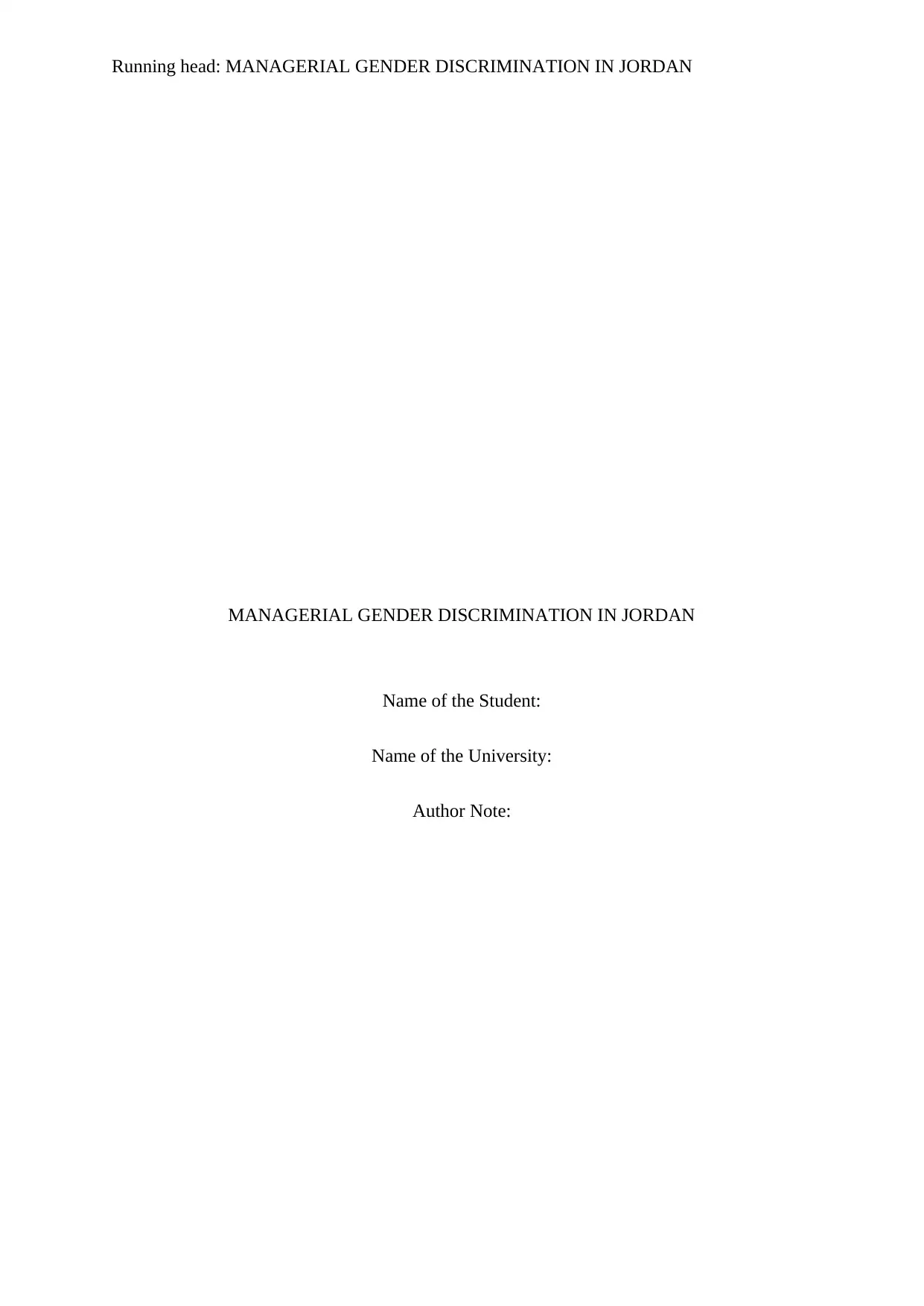
Running head: MANAGERIAL GENDER DISCRIMINATION IN JORDAN
MANAGERIAL GENDER DISCRIMINATION IN JORDAN
Name of the Student:
Name of the University:
Author Note:
MANAGERIAL GENDER DISCRIMINATION IN JORDAN
Name of the Student:
Name of the University:
Author Note:
Paraphrase This Document
Need a fresh take? Get an instant paraphrase of this document with our AI Paraphraser
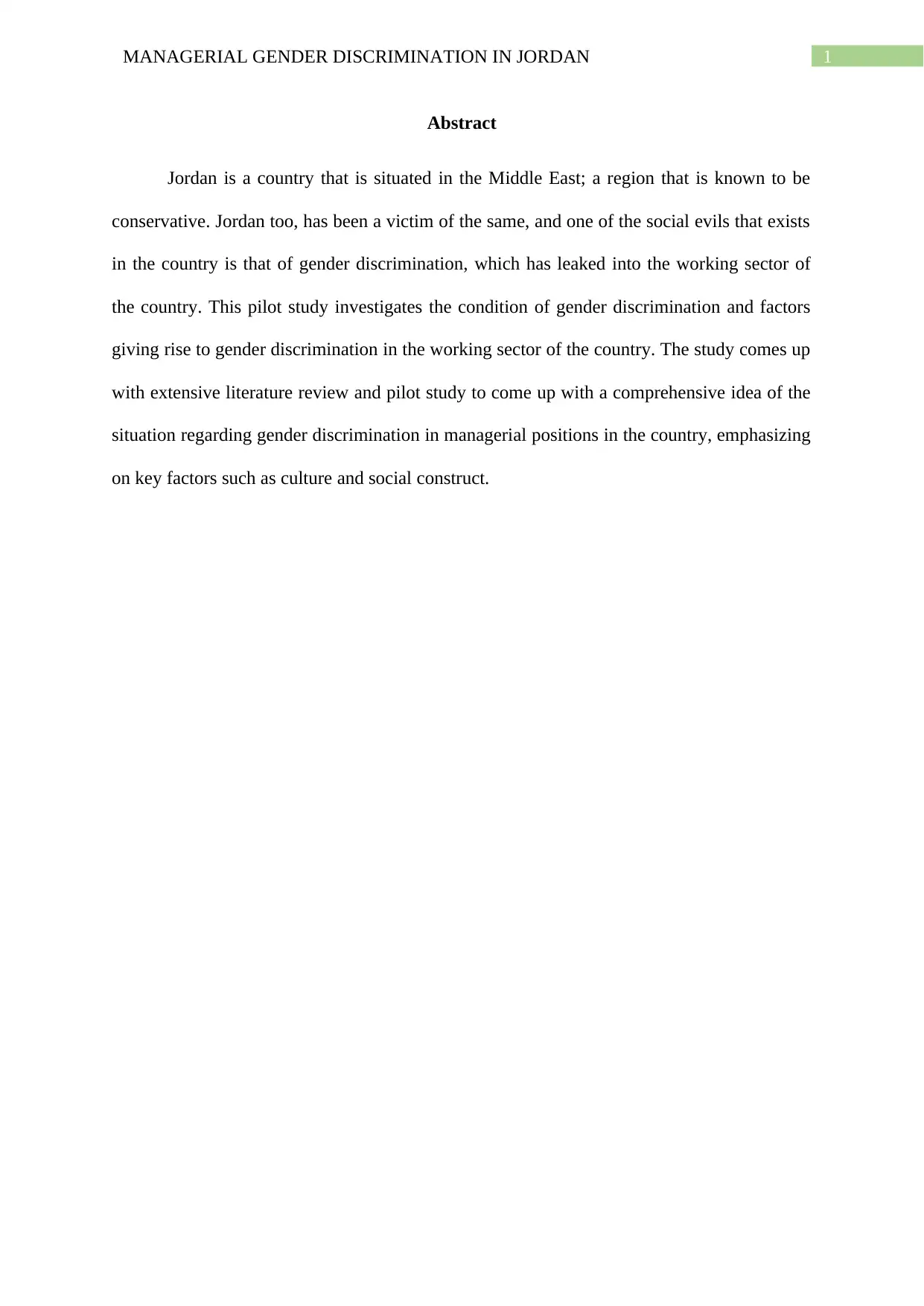
1MANAGERIAL GENDER DISCRIMINATION IN JORDAN
Abstract
Jordan is a country that is situated in the Middle East; a region that is known to be
conservative. Jordan too, has been a victim of the same, and one of the social evils that exists
in the country is that of gender discrimination, which has leaked into the working sector of
the country. This pilot study investigates the condition of gender discrimination and factors
giving rise to gender discrimination in the working sector of the country. The study comes up
with extensive literature review and pilot study to come up with a comprehensive idea of the
situation regarding gender discrimination in managerial positions in the country, emphasizing
on key factors such as culture and social construct.
Abstract
Jordan is a country that is situated in the Middle East; a region that is known to be
conservative. Jordan too, has been a victim of the same, and one of the social evils that exists
in the country is that of gender discrimination, which has leaked into the working sector of
the country. This pilot study investigates the condition of gender discrimination and factors
giving rise to gender discrimination in the working sector of the country. The study comes up
with extensive literature review and pilot study to come up with a comprehensive idea of the
situation regarding gender discrimination in managerial positions in the country, emphasizing
on key factors such as culture and social construct.
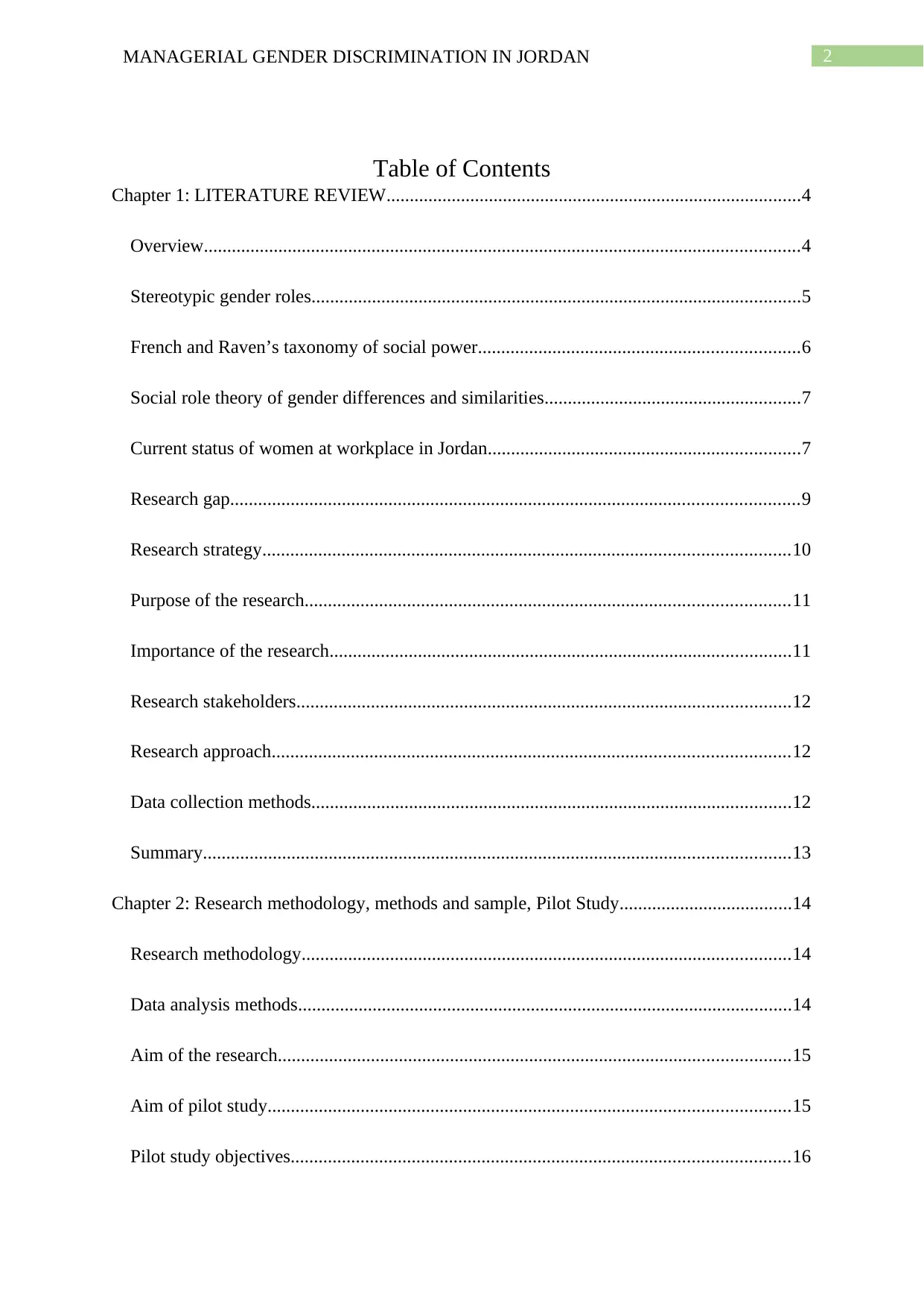
2MANAGERIAL GENDER DISCRIMINATION IN JORDAN
Table of Contents
Chapter 1: LITERATURE REVIEW.........................................................................................4
Overview................................................................................................................................4
Stereotypic gender roles.........................................................................................................5
French and Raven’s taxonomy of social power.....................................................................6
Social role theory of gender differences and similarities.......................................................7
Current status of women at workplace in Jordan...................................................................7
Research gap..........................................................................................................................9
Research strategy.................................................................................................................10
Purpose of the research........................................................................................................11
Importance of the research...................................................................................................11
Research stakeholders..........................................................................................................12
Research approach...............................................................................................................12
Data collection methods.......................................................................................................12
Summary..............................................................................................................................13
Chapter 2: Research methodology, methods and sample, Pilot Study.....................................14
Research methodology.........................................................................................................14
Data analysis methods..........................................................................................................14
Aim of the research..............................................................................................................15
Aim of pilot study................................................................................................................15
Pilot study objectives...........................................................................................................16
Table of Contents
Chapter 1: LITERATURE REVIEW.........................................................................................4
Overview................................................................................................................................4
Stereotypic gender roles.........................................................................................................5
French and Raven’s taxonomy of social power.....................................................................6
Social role theory of gender differences and similarities.......................................................7
Current status of women at workplace in Jordan...................................................................7
Research gap..........................................................................................................................9
Research strategy.................................................................................................................10
Purpose of the research........................................................................................................11
Importance of the research...................................................................................................11
Research stakeholders..........................................................................................................12
Research approach...............................................................................................................12
Data collection methods.......................................................................................................12
Summary..............................................................................................................................13
Chapter 2: Research methodology, methods and sample, Pilot Study.....................................14
Research methodology.........................................................................................................14
Data analysis methods..........................................................................................................14
Aim of the research..............................................................................................................15
Aim of pilot study................................................................................................................15
Pilot study objectives...........................................................................................................16
⊘ This is a preview!⊘
Do you want full access?
Subscribe today to unlock all pages.

Trusted by 1+ million students worldwide
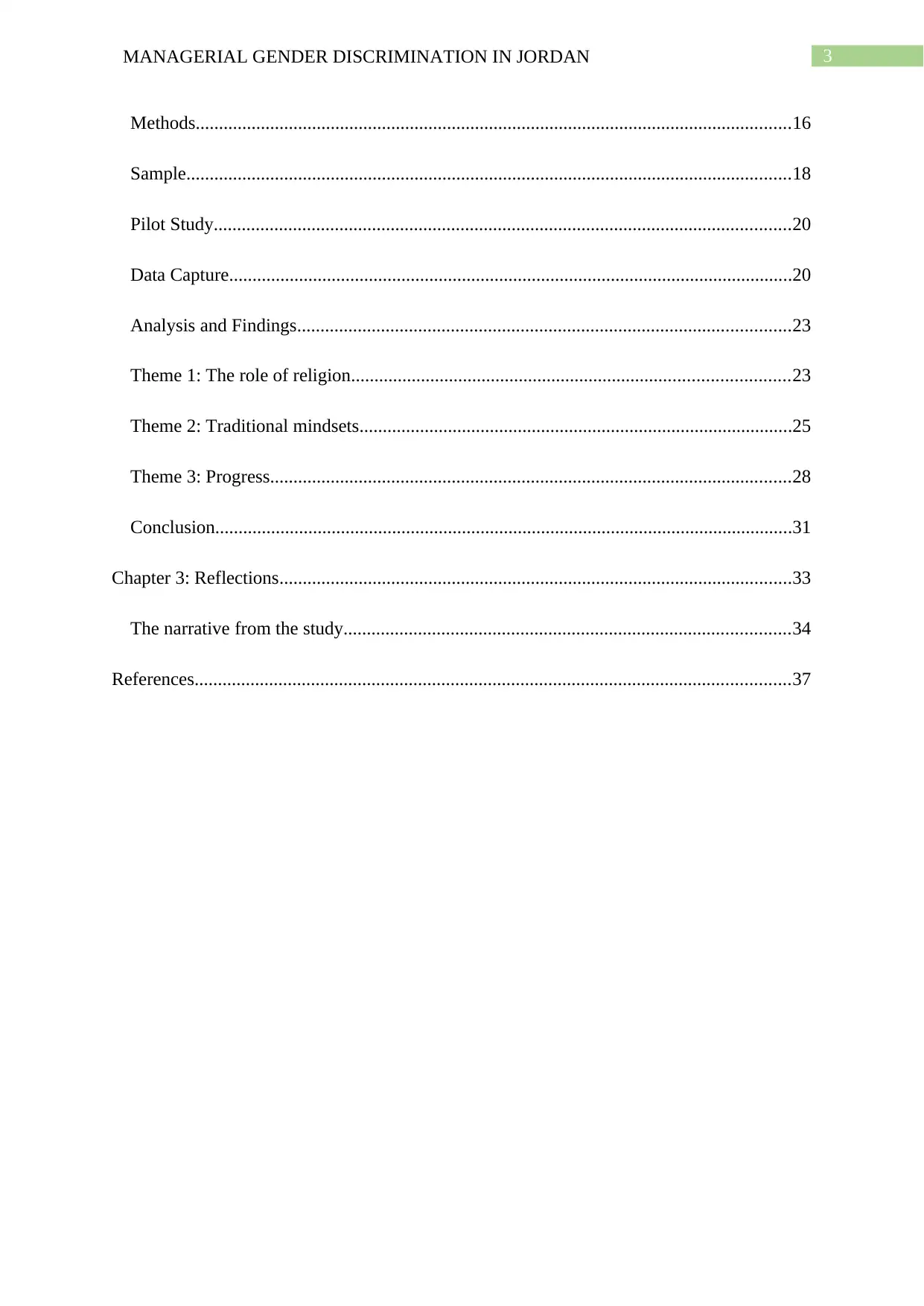
3MANAGERIAL GENDER DISCRIMINATION IN JORDAN
Methods................................................................................................................................16
Sample..................................................................................................................................18
Pilot Study............................................................................................................................20
Data Capture.........................................................................................................................20
Analysis and Findings..........................................................................................................23
Theme 1: The role of religion..............................................................................................23
Theme 2: Traditional mindsets.............................................................................................25
Theme 3: Progress................................................................................................................28
Conclusion............................................................................................................................31
Chapter 3: Reflections..............................................................................................................33
The narrative from the study................................................................................................34
References................................................................................................................................37
Methods................................................................................................................................16
Sample..................................................................................................................................18
Pilot Study............................................................................................................................20
Data Capture.........................................................................................................................20
Analysis and Findings..........................................................................................................23
Theme 1: The role of religion..............................................................................................23
Theme 2: Traditional mindsets.............................................................................................25
Theme 3: Progress................................................................................................................28
Conclusion............................................................................................................................31
Chapter 3: Reflections..............................................................................................................33
The narrative from the study................................................................................................34
References................................................................................................................................37
Paraphrase This Document
Need a fresh take? Get an instant paraphrase of this document with our AI Paraphraser
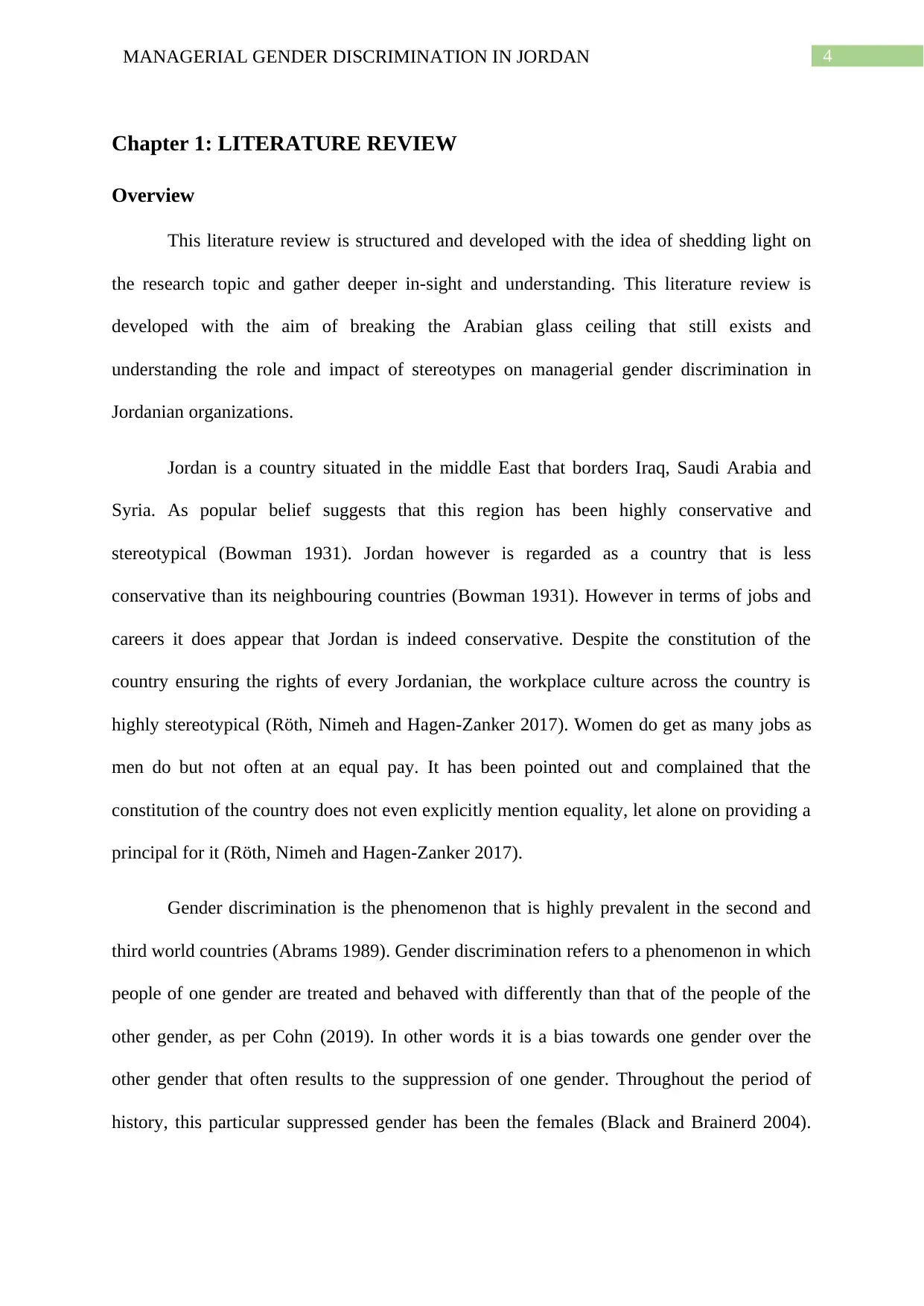
4MANAGERIAL GENDER DISCRIMINATION IN JORDAN
Chapter 1: LITERATURE REVIEW
Overview
This literature review is structured and developed with the idea of shedding light on
the research topic and gather deeper in-sight and understanding. This literature review is
developed with the aim of breaking the Arabian glass ceiling that still exists and
understanding the role and impact of stereotypes on managerial gender discrimination in
Jordanian organizations.
Jordan is a country situated in the middle East that borders Iraq, Saudi Arabia and
Syria. As popular belief suggests that this region has been highly conservative and
stereotypical (Bowman 1931). Jordan however is regarded as a country that is less
conservative than its neighbouring countries (Bowman 1931). However in terms of jobs and
careers it does appear that Jordan is indeed conservative. Despite the constitution of the
country ensuring the rights of every Jordanian, the workplace culture across the country is
highly stereotypical (Röth, Nimeh and Hagen-Zanker 2017). Women do get as many jobs as
men do but not often at an equal pay. It has been pointed out and complained that the
constitution of the country does not even explicitly mention equality, let alone on providing a
principal for it (Röth, Nimeh and Hagen-Zanker 2017).
Gender discrimination is the phenomenon that is highly prevalent in the second and
third world countries (Abrams 1989). Gender discrimination refers to a phenomenon in which
people of one gender are treated and behaved with differently than that of the people of the
other gender, as per Cohn (2019). In other words it is a bias towards one gender over the
other gender that often results to the suppression of one gender. Throughout the period of
history, this particular suppressed gender has been the females (Black and Brainerd 2004).
Chapter 1: LITERATURE REVIEW
Overview
This literature review is structured and developed with the idea of shedding light on
the research topic and gather deeper in-sight and understanding. This literature review is
developed with the aim of breaking the Arabian glass ceiling that still exists and
understanding the role and impact of stereotypes on managerial gender discrimination in
Jordanian organizations.
Jordan is a country situated in the middle East that borders Iraq, Saudi Arabia and
Syria. As popular belief suggests that this region has been highly conservative and
stereotypical (Bowman 1931). Jordan however is regarded as a country that is less
conservative than its neighbouring countries (Bowman 1931). However in terms of jobs and
careers it does appear that Jordan is indeed conservative. Despite the constitution of the
country ensuring the rights of every Jordanian, the workplace culture across the country is
highly stereotypical (Röth, Nimeh and Hagen-Zanker 2017). Women do get as many jobs as
men do but not often at an equal pay. It has been pointed out and complained that the
constitution of the country does not even explicitly mention equality, let alone on providing a
principal for it (Röth, Nimeh and Hagen-Zanker 2017).
Gender discrimination is the phenomenon that is highly prevalent in the second and
third world countries (Abrams 1989). Gender discrimination refers to a phenomenon in which
people of one gender are treated and behaved with differently than that of the people of the
other gender, as per Cohn (2019). In other words it is a bias towards one gender over the
other gender that often results to the suppression of one gender. Throughout the period of
history, this particular suppressed gender has been the females (Black and Brainerd 2004).
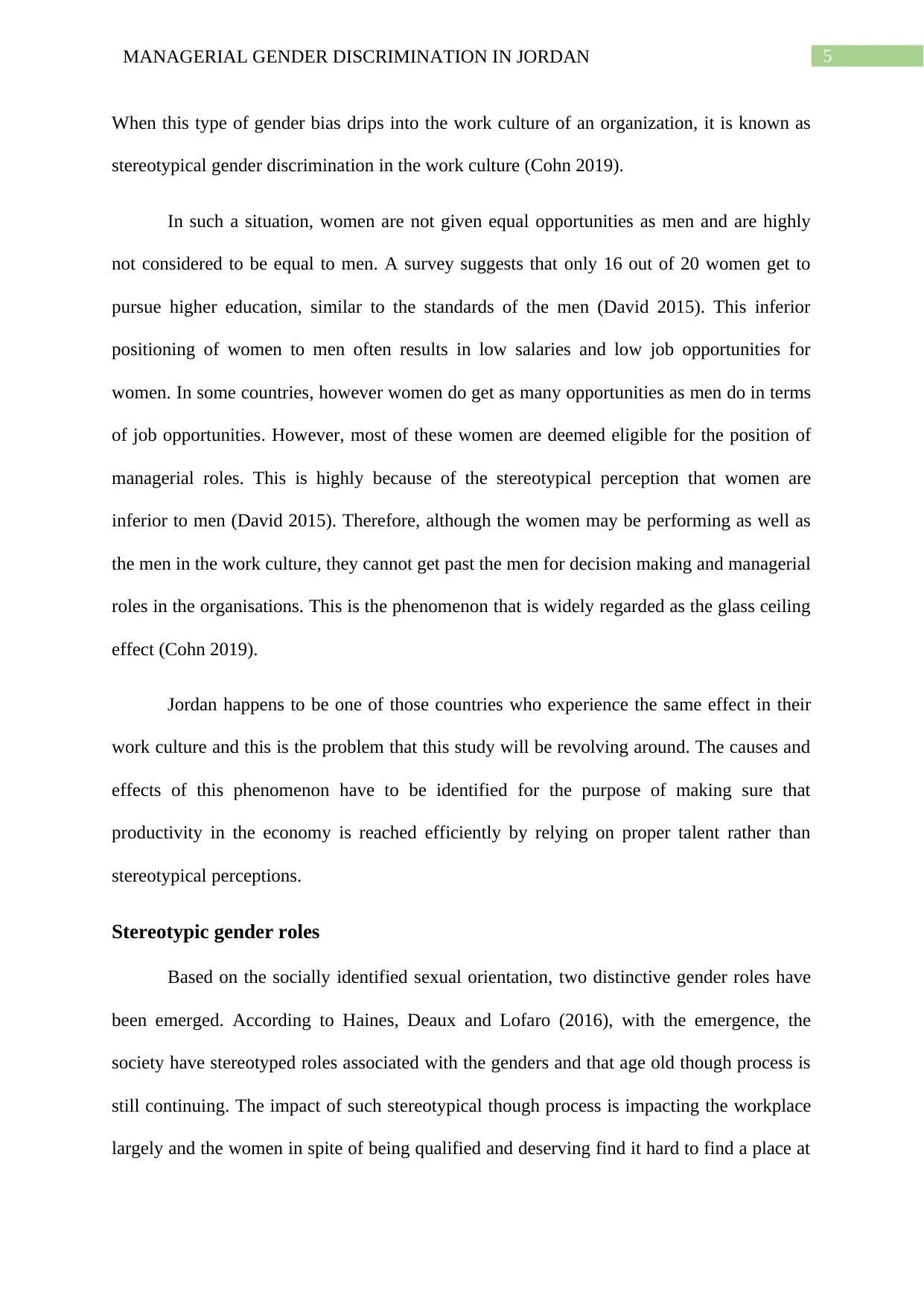
5MANAGERIAL GENDER DISCRIMINATION IN JORDAN
When this type of gender bias drips into the work culture of an organization, it is known as
stereotypical gender discrimination in the work culture (Cohn 2019).
In such a situation, women are not given equal opportunities as men and are highly
not considered to be equal to men. A survey suggests that only 16 out of 20 women get to
pursue higher education, similar to the standards of the men (David 2015). This inferior
positioning of women to men often results in low salaries and low job opportunities for
women. In some countries, however women do get as many opportunities as men do in terms
of job opportunities. However, most of these women are deemed eligible for the position of
managerial roles. This is highly because of the stereotypical perception that women are
inferior to men (David 2015). Therefore, although the women may be performing as well as
the men in the work culture, they cannot get past the men for decision making and managerial
roles in the organisations. This is the phenomenon that is widely regarded as the glass ceiling
effect (Cohn 2019).
Jordan happens to be one of those countries who experience the same effect in their
work culture and this is the problem that this study will be revolving around. The causes and
effects of this phenomenon have to be identified for the purpose of making sure that
productivity in the economy is reached efficiently by relying on proper talent rather than
stereotypical perceptions.
Stereotypic gender roles
Based on the socially identified sexual orientation, two distinctive gender roles have
been emerged. According to Haines, Deaux and Lofaro (2016), with the emergence, the
society have stereotyped roles associated with the genders and that age old though process is
still continuing. The impact of such stereotypical though process is impacting the workplace
largely and the women in spite of being qualified and deserving find it hard to find a place at
When this type of gender bias drips into the work culture of an organization, it is known as
stereotypical gender discrimination in the work culture (Cohn 2019).
In such a situation, women are not given equal opportunities as men and are highly
not considered to be equal to men. A survey suggests that only 16 out of 20 women get to
pursue higher education, similar to the standards of the men (David 2015). This inferior
positioning of women to men often results in low salaries and low job opportunities for
women. In some countries, however women do get as many opportunities as men do in terms
of job opportunities. However, most of these women are deemed eligible for the position of
managerial roles. This is highly because of the stereotypical perception that women are
inferior to men (David 2015). Therefore, although the women may be performing as well as
the men in the work culture, they cannot get past the men for decision making and managerial
roles in the organisations. This is the phenomenon that is widely regarded as the glass ceiling
effect (Cohn 2019).
Jordan happens to be one of those countries who experience the same effect in their
work culture and this is the problem that this study will be revolving around. The causes and
effects of this phenomenon have to be identified for the purpose of making sure that
productivity in the economy is reached efficiently by relying on proper talent rather than
stereotypical perceptions.
Stereotypic gender roles
Based on the socially identified sexual orientation, two distinctive gender roles have
been emerged. According to Haines, Deaux and Lofaro (2016), with the emergence, the
society have stereotyped roles associated with the genders and that age old though process is
still continuing. The impact of such stereotypical though process is impacting the workplace
largely and the women in spite of being qualified and deserving find it hard to find a place at
⊘ This is a preview!⊘
Do you want full access?
Subscribe today to unlock all pages.

Trusted by 1+ million students worldwide
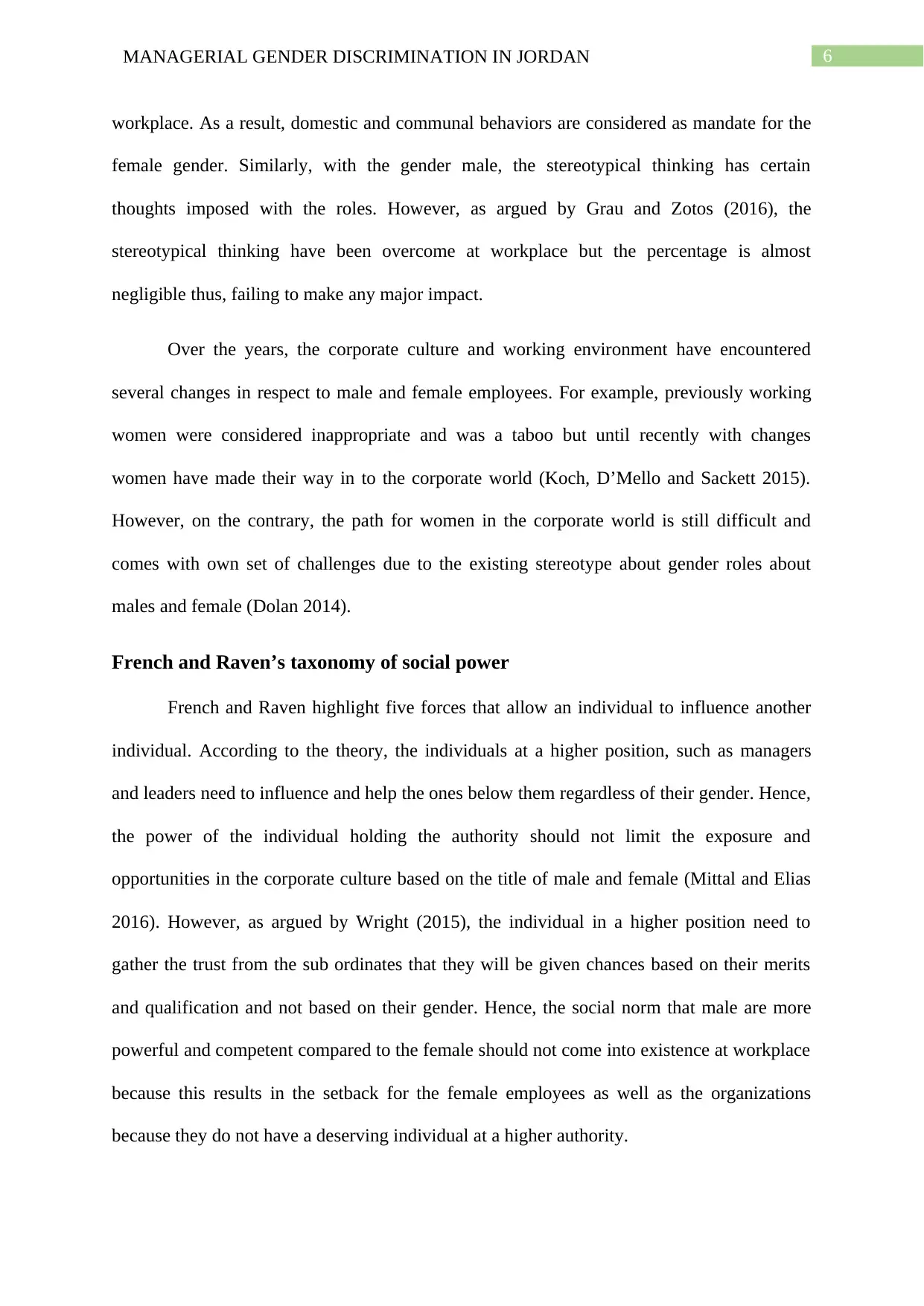
6MANAGERIAL GENDER DISCRIMINATION IN JORDAN
workplace. As a result, domestic and communal behaviors are considered as mandate for the
female gender. Similarly, with the gender male, the stereotypical thinking has certain
thoughts imposed with the roles. However, as argued by Grau and Zotos (2016), the
stereotypical thinking have been overcome at workplace but the percentage is almost
negligible thus, failing to make any major impact.
Over the years, the corporate culture and working environment have encountered
several changes in respect to male and female employees. For example, previously working
women were considered inappropriate and was a taboo but until recently with changes
women have made their way in to the corporate world (Koch, D’Mello and Sackett 2015).
However, on the contrary, the path for women in the corporate world is still difficult and
comes with own set of challenges due to the existing stereotype about gender roles about
males and female (Dolan 2014).
French and Raven’s taxonomy of social power
French and Raven highlight five forces that allow an individual to influence another
individual. According to the theory, the individuals at a higher position, such as managers
and leaders need to influence and help the ones below them regardless of their gender. Hence,
the power of the individual holding the authority should not limit the exposure and
opportunities in the corporate culture based on the title of male and female (Mittal and Elias
2016). However, as argued by Wright (2015), the individual in a higher position need to
gather the trust from the sub ordinates that they will be given chances based on their merits
and qualification and not based on their gender. Hence, the social norm that male are more
powerful and competent compared to the female should not come into existence at workplace
because this results in the setback for the female employees as well as the organizations
because they do not have a deserving individual at a higher authority.
workplace. As a result, domestic and communal behaviors are considered as mandate for the
female gender. Similarly, with the gender male, the stereotypical thinking has certain
thoughts imposed with the roles. However, as argued by Grau and Zotos (2016), the
stereotypical thinking have been overcome at workplace but the percentage is almost
negligible thus, failing to make any major impact.
Over the years, the corporate culture and working environment have encountered
several changes in respect to male and female employees. For example, previously working
women were considered inappropriate and was a taboo but until recently with changes
women have made their way in to the corporate world (Koch, D’Mello and Sackett 2015).
However, on the contrary, the path for women in the corporate world is still difficult and
comes with own set of challenges due to the existing stereotype about gender roles about
males and female (Dolan 2014).
French and Raven’s taxonomy of social power
French and Raven highlight five forces that allow an individual to influence another
individual. According to the theory, the individuals at a higher position, such as managers
and leaders need to influence and help the ones below them regardless of their gender. Hence,
the power of the individual holding the authority should not limit the exposure and
opportunities in the corporate culture based on the title of male and female (Mittal and Elias
2016). However, as argued by Wright (2015), the individual in a higher position need to
gather the trust from the sub ordinates that they will be given chances based on their merits
and qualification and not based on their gender. Hence, the social norm that male are more
powerful and competent compared to the female should not come into existence at workplace
because this results in the setback for the female employees as well as the organizations
because they do not have a deserving individual at a higher authority.
Paraphrase This Document
Need a fresh take? Get an instant paraphrase of this document with our AI Paraphraser
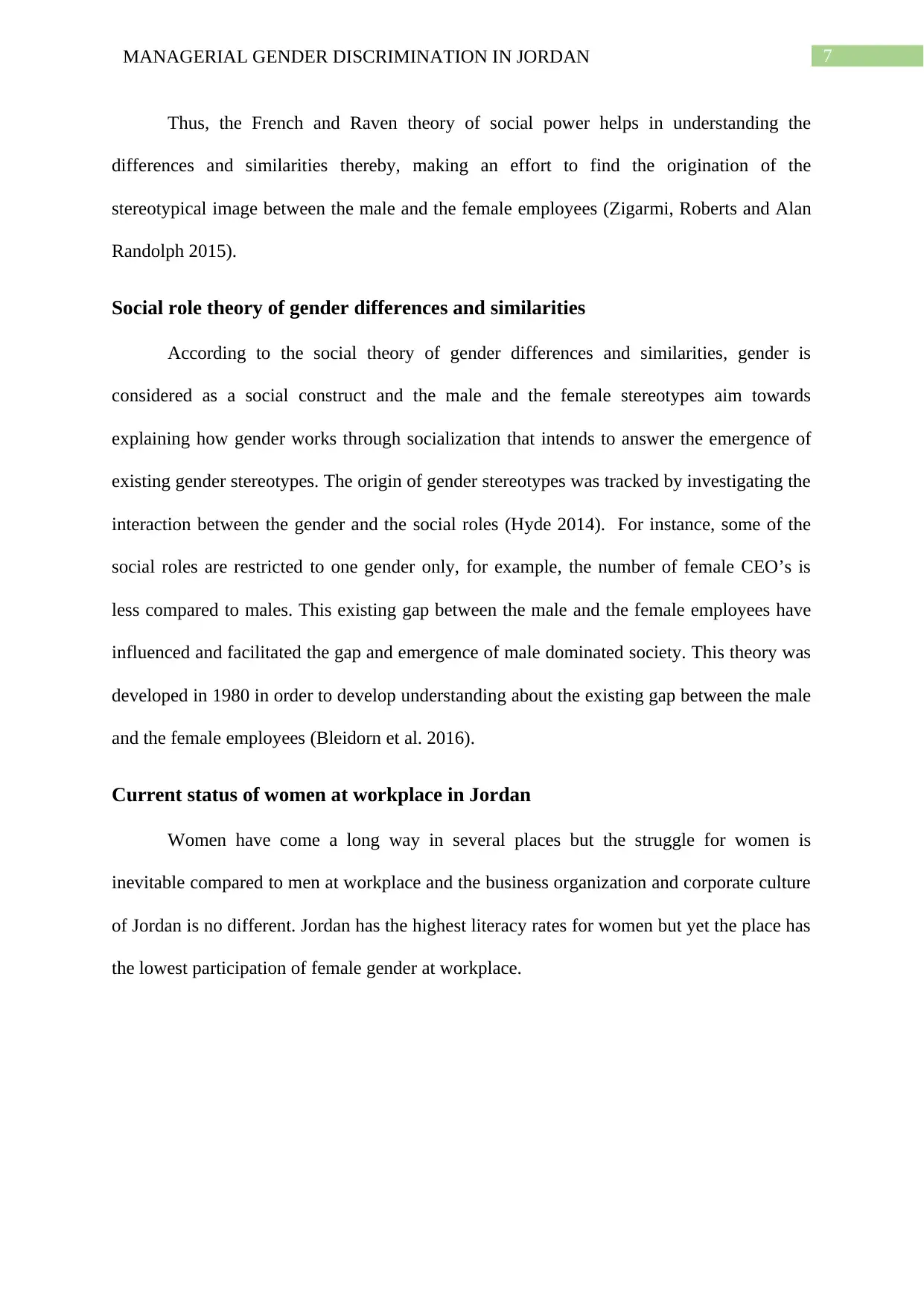
7MANAGERIAL GENDER DISCRIMINATION IN JORDAN
Thus, the French and Raven theory of social power helps in understanding the
differences and similarities thereby, making an effort to find the origination of the
stereotypical image between the male and the female employees (Zigarmi, Roberts and Alan
Randolph 2015).
Social role theory of gender differences and similarities
According to the social theory of gender differences and similarities, gender is
considered as a social construct and the male and the female stereotypes aim towards
explaining how gender works through socialization that intends to answer the emergence of
existing gender stereotypes. The origin of gender stereotypes was tracked by investigating the
interaction between the gender and the social roles (Hyde 2014). For instance, some of the
social roles are restricted to one gender only, for example, the number of female CEO’s is
less compared to males. This existing gap between the male and the female employees have
influenced and facilitated the gap and emergence of male dominated society. This theory was
developed in 1980 in order to develop understanding about the existing gap between the male
and the female employees (Bleidorn et al. 2016).
Current status of women at workplace in Jordan
Women have come a long way in several places but the struggle for women is
inevitable compared to men at workplace and the business organization and corporate culture
of Jordan is no different. Jordan has the highest literacy rates for women but yet the place has
the lowest participation of female gender at workplace.
Thus, the French and Raven theory of social power helps in understanding the
differences and similarities thereby, making an effort to find the origination of the
stereotypical image between the male and the female employees (Zigarmi, Roberts and Alan
Randolph 2015).
Social role theory of gender differences and similarities
According to the social theory of gender differences and similarities, gender is
considered as a social construct and the male and the female stereotypes aim towards
explaining how gender works through socialization that intends to answer the emergence of
existing gender stereotypes. The origin of gender stereotypes was tracked by investigating the
interaction between the gender and the social roles (Hyde 2014). For instance, some of the
social roles are restricted to one gender only, for example, the number of female CEO’s is
less compared to males. This existing gap between the male and the female employees have
influenced and facilitated the gap and emergence of male dominated society. This theory was
developed in 1980 in order to develop understanding about the existing gap between the male
and the female employees (Bleidorn et al. 2016).
Current status of women at workplace in Jordan
Women have come a long way in several places but the struggle for women is
inevitable compared to men at workplace and the business organization and corporate culture
of Jordan is no different. Jordan has the highest literacy rates for women but yet the place has
the lowest participation of female gender at workplace.
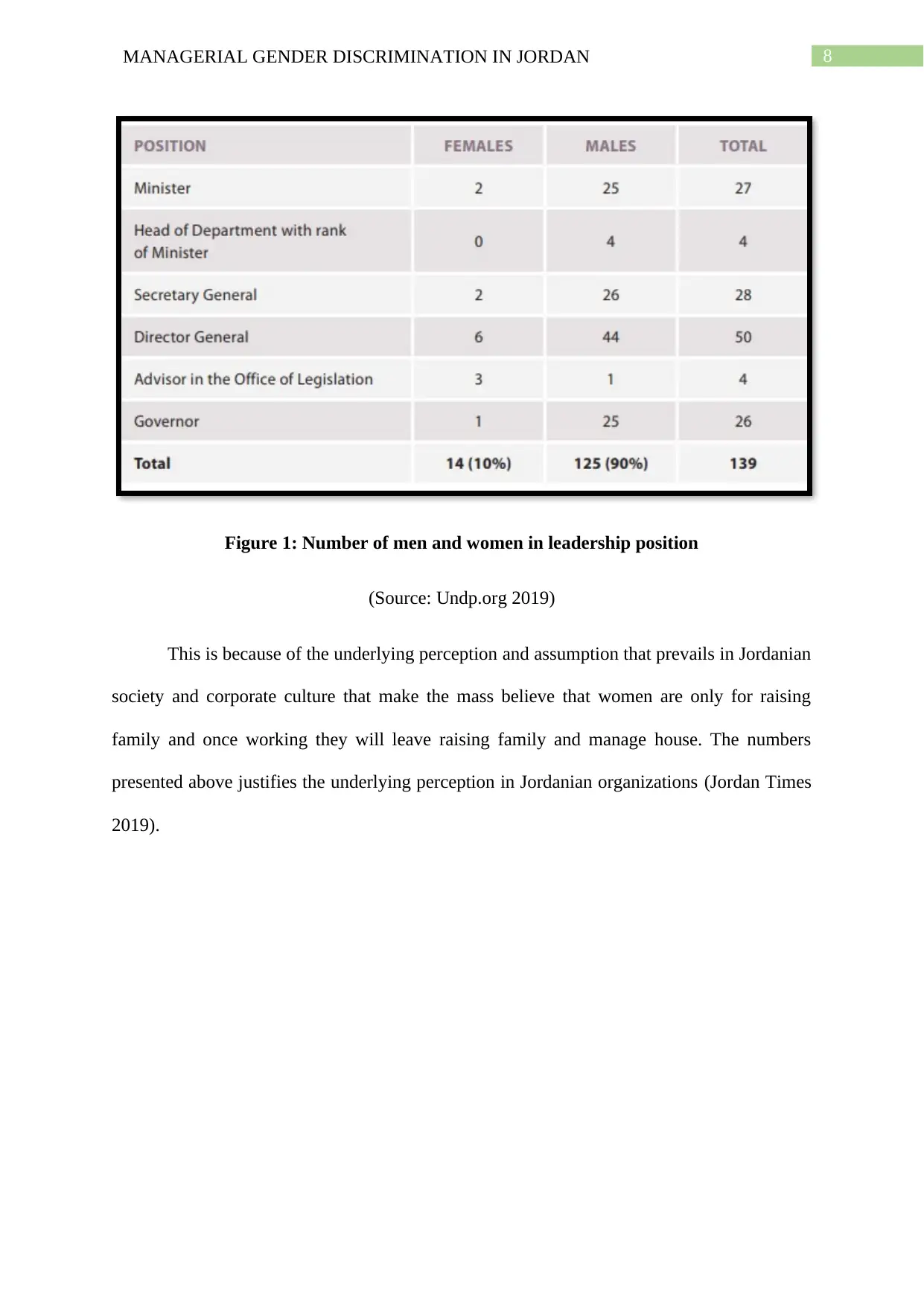
8MANAGERIAL GENDER DISCRIMINATION IN JORDAN
Figure 1: Number of men and women in leadership position
(Source: Undp.org 2019)
This is because of the underlying perception and assumption that prevails in Jordanian
society and corporate culture that make the mass believe that women are only for raising
family and once working they will leave raising family and manage house. The numbers
presented above justifies the underlying perception in Jordanian organizations (Jordan Times
2019).
Figure 1: Number of men and women in leadership position
(Source: Undp.org 2019)
This is because of the underlying perception and assumption that prevails in Jordanian
society and corporate culture that make the mass believe that women are only for raising
family and once working they will leave raising family and manage house. The numbers
presented above justifies the underlying perception in Jordanian organizations (Jordan Times
2019).
⊘ This is a preview!⊘
Do you want full access?
Subscribe today to unlock all pages.

Trusted by 1+ million students worldwide
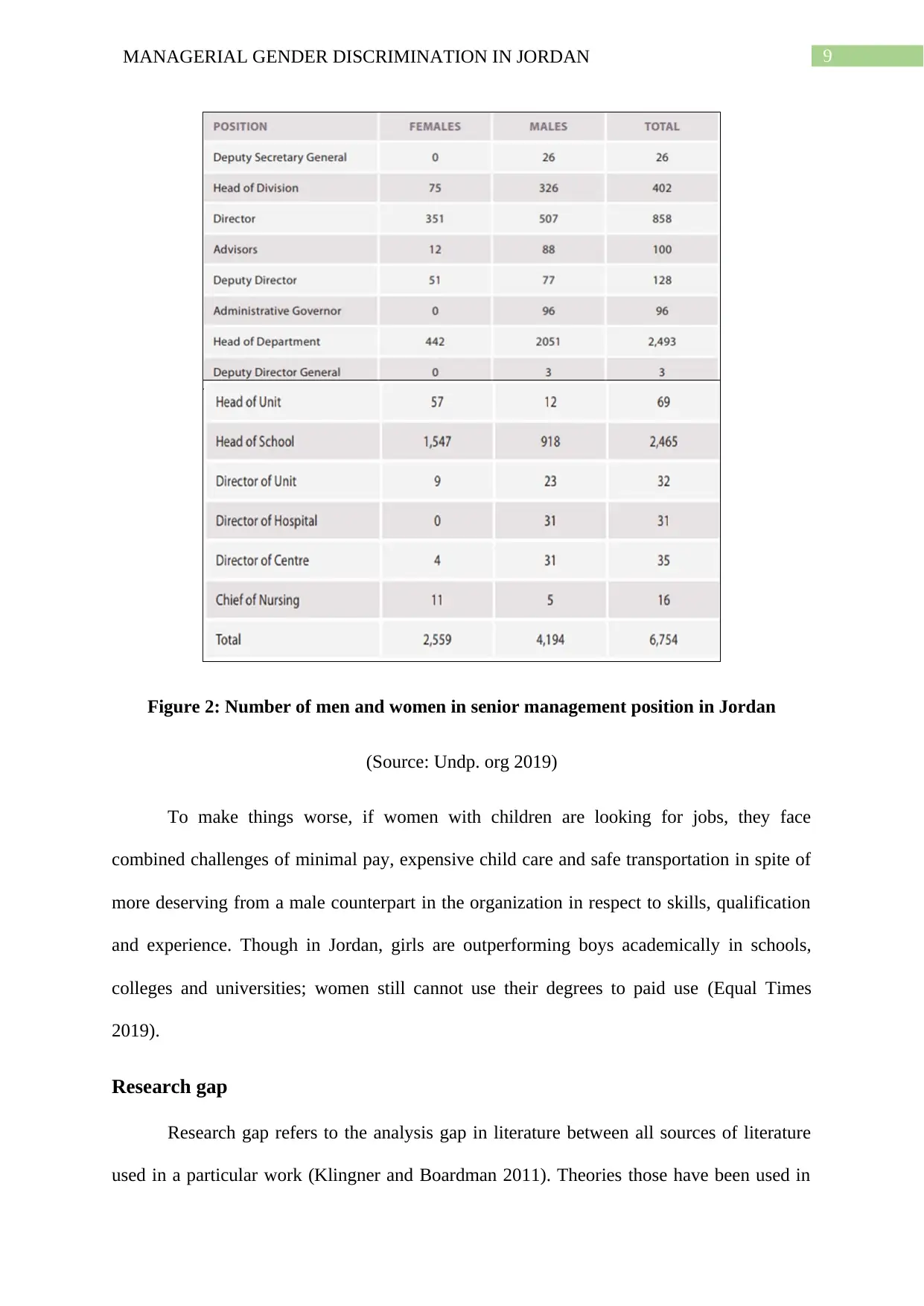
9MANAGERIAL GENDER DISCRIMINATION IN JORDAN
Figure 2: Number of men and women in senior management position in Jordan
(Source: Undp. org 2019)
To make things worse, if women with children are looking for jobs, they face
combined challenges of minimal pay, expensive child care and safe transportation in spite of
more deserving from a male counterpart in the organization in respect to skills, qualification
and experience. Though in Jordan, girls are outperforming boys academically in schools,
colleges and universities; women still cannot use their degrees to paid use (Equal Times
2019).
Research gap
Research gap refers to the analysis gap in literature between all sources of literature
used in a particular work (Klingner and Boardman 2011). Theories those have been used in
Figure 2: Number of men and women in senior management position in Jordan
(Source: Undp. org 2019)
To make things worse, if women with children are looking for jobs, they face
combined challenges of minimal pay, expensive child care and safe transportation in spite of
more deserving from a male counterpart in the organization in respect to skills, qualification
and experience. Though in Jordan, girls are outperforming boys academically in schools,
colleges and universities; women still cannot use their degrees to paid use (Equal Times
2019).
Research gap
Research gap refers to the analysis gap in literature between all sources of literature
used in a particular work (Klingner and Boardman 2011). Theories those have been used in
Paraphrase This Document
Need a fresh take? Get an instant paraphrase of this document with our AI Paraphraser
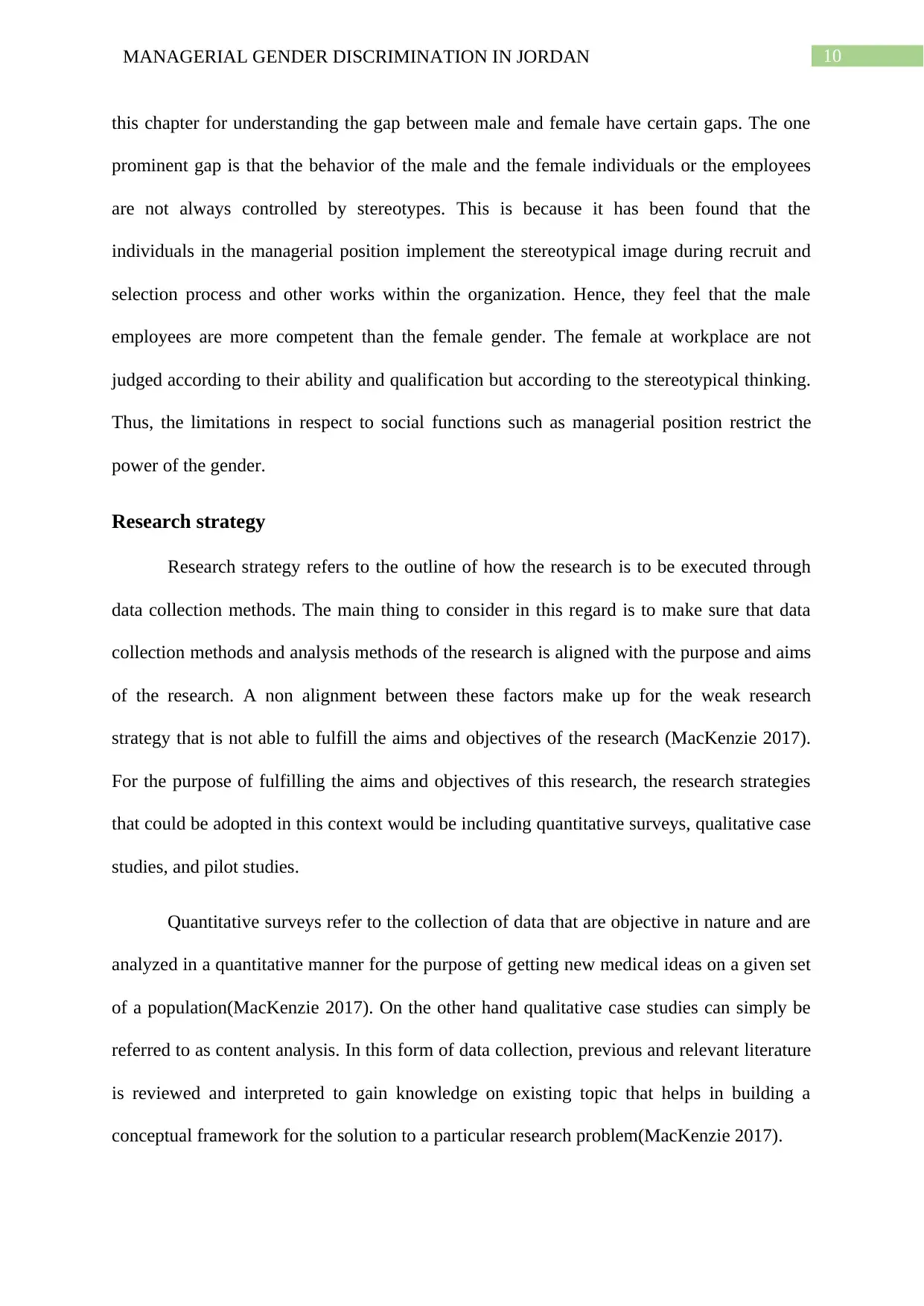
10MANAGERIAL GENDER DISCRIMINATION IN JORDAN
this chapter for understanding the gap between male and female have certain gaps. The one
prominent gap is that the behavior of the male and the female individuals or the employees
are not always controlled by stereotypes. This is because it has been found that the
individuals in the managerial position implement the stereotypical image during recruit and
selection process and other works within the organization. Hence, they feel that the male
employees are more competent than the female gender. The female at workplace are not
judged according to their ability and qualification but according to the stereotypical thinking.
Thus, the limitations in respect to social functions such as managerial position restrict the
power of the gender.
Research strategy
Research strategy refers to the outline of how the research is to be executed through
data collection methods. The main thing to consider in this regard is to make sure that data
collection methods and analysis methods of the research is aligned with the purpose and aims
of the research. A non alignment between these factors make up for the weak research
strategy that is not able to fulfill the aims and objectives of the research (MacKenzie 2017).
For the purpose of fulfilling the aims and objectives of this research, the research strategies
that could be adopted in this context would be including quantitative surveys, qualitative case
studies, and pilot studies.
Quantitative surveys refer to the collection of data that are objective in nature and are
analyzed in a quantitative manner for the purpose of getting new medical ideas on a given set
of a population(MacKenzie 2017). On the other hand qualitative case studies can simply be
referred to as content analysis. In this form of data collection, previous and relevant literature
is reviewed and interpreted to gain knowledge on existing topic that helps in building a
conceptual framework for the solution to a particular research problem(MacKenzie 2017).
this chapter for understanding the gap between male and female have certain gaps. The one
prominent gap is that the behavior of the male and the female individuals or the employees
are not always controlled by stereotypes. This is because it has been found that the
individuals in the managerial position implement the stereotypical image during recruit and
selection process and other works within the organization. Hence, they feel that the male
employees are more competent than the female gender. The female at workplace are not
judged according to their ability and qualification but according to the stereotypical thinking.
Thus, the limitations in respect to social functions such as managerial position restrict the
power of the gender.
Research strategy
Research strategy refers to the outline of how the research is to be executed through
data collection methods. The main thing to consider in this regard is to make sure that data
collection methods and analysis methods of the research is aligned with the purpose and aims
of the research. A non alignment between these factors make up for the weak research
strategy that is not able to fulfill the aims and objectives of the research (MacKenzie 2017).
For the purpose of fulfilling the aims and objectives of this research, the research strategies
that could be adopted in this context would be including quantitative surveys, qualitative case
studies, and pilot studies.
Quantitative surveys refer to the collection of data that are objective in nature and are
analyzed in a quantitative manner for the purpose of getting new medical ideas on a given set
of a population(MacKenzie 2017). On the other hand qualitative case studies can simply be
referred to as content analysis. In this form of data collection, previous and relevant literature
is reviewed and interpreted to gain knowledge on existing topic that helps in building a
conceptual framework for the solution to a particular research problem(MacKenzie 2017).
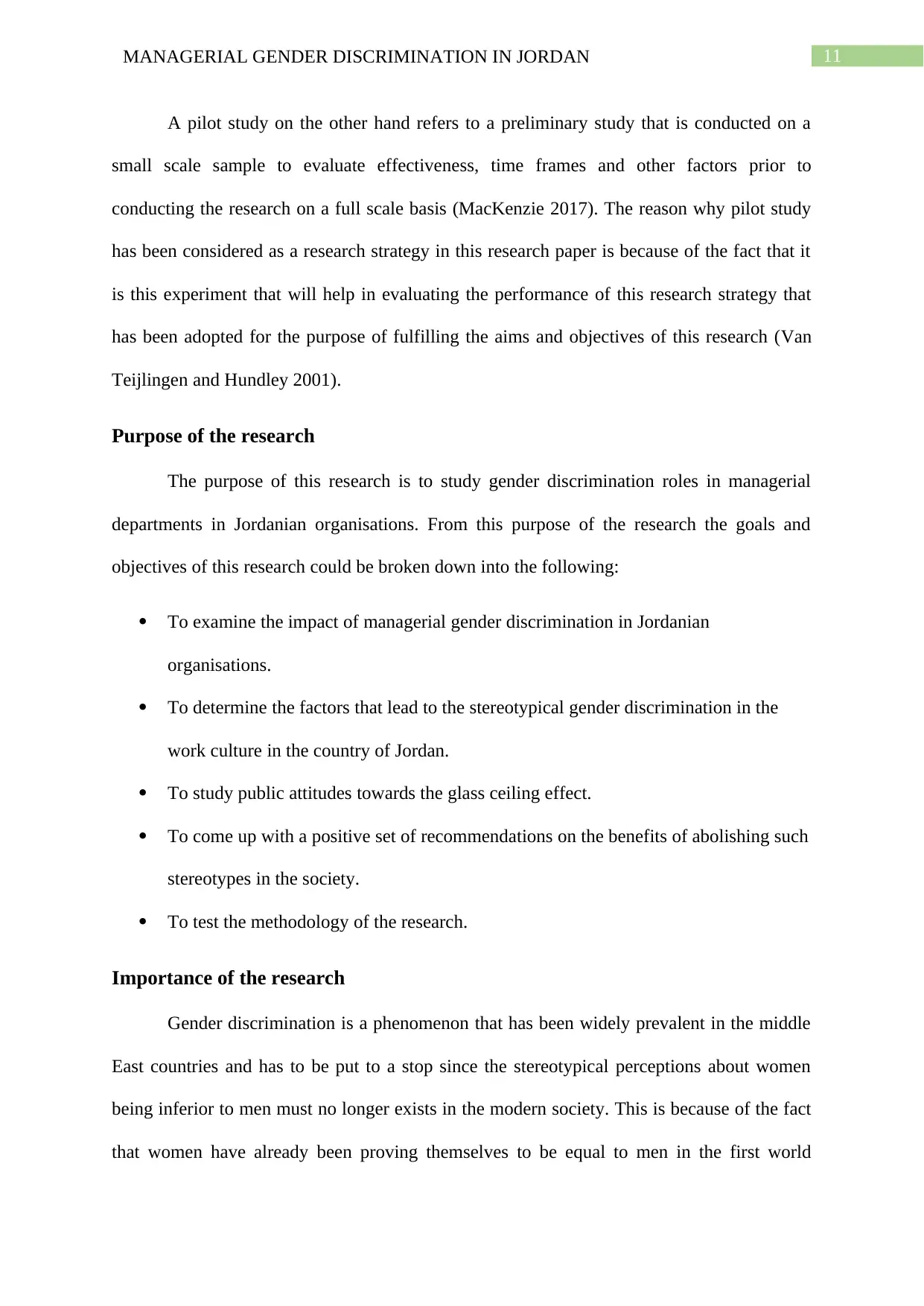
11MANAGERIAL GENDER DISCRIMINATION IN JORDAN
A pilot study on the other hand refers to a preliminary study that is conducted on a
small scale sample to evaluate effectiveness, time frames and other factors prior to
conducting the research on a full scale basis (MacKenzie 2017). The reason why pilot study
has been considered as a research strategy in this research paper is because of the fact that it
is this experiment that will help in evaluating the performance of this research strategy that
has been adopted for the purpose of fulfilling the aims and objectives of this research (Van
Teijlingen and Hundley 2001).
Purpose of the research
The purpose of this research is to study gender discrimination roles in managerial
departments in Jordanian organisations. From this purpose of the research the goals and
objectives of this research could be broken down into the following:
To examine the impact of managerial gender discrimination in Jordanian
organisations.
To determine the factors that lead to the stereotypical gender discrimination in the
work culture in the country of Jordan.
To study public attitudes towards the glass ceiling effect.
To come up with a positive set of recommendations on the benefits of abolishing such
stereotypes in the society.
To test the methodology of the research.
Importance of the research
Gender discrimination is a phenomenon that has been widely prevalent in the middle
East countries and has to be put to a stop since the stereotypical perceptions about women
being inferior to men must no longer exists in the modern society. This is because of the fact
that women have already been proving themselves to be equal to men in the first world
A pilot study on the other hand refers to a preliminary study that is conducted on a
small scale sample to evaluate effectiveness, time frames and other factors prior to
conducting the research on a full scale basis (MacKenzie 2017). The reason why pilot study
has been considered as a research strategy in this research paper is because of the fact that it
is this experiment that will help in evaluating the performance of this research strategy that
has been adopted for the purpose of fulfilling the aims and objectives of this research (Van
Teijlingen and Hundley 2001).
Purpose of the research
The purpose of this research is to study gender discrimination roles in managerial
departments in Jordanian organisations. From this purpose of the research the goals and
objectives of this research could be broken down into the following:
To examine the impact of managerial gender discrimination in Jordanian
organisations.
To determine the factors that lead to the stereotypical gender discrimination in the
work culture in the country of Jordan.
To study public attitudes towards the glass ceiling effect.
To come up with a positive set of recommendations on the benefits of abolishing such
stereotypes in the society.
To test the methodology of the research.
Importance of the research
Gender discrimination is a phenomenon that has been widely prevalent in the middle
East countries and has to be put to a stop since the stereotypical perceptions about women
being inferior to men must no longer exists in the modern society. This is because of the fact
that women have already been proving themselves to be equal to men in the first world
⊘ This is a preview!⊘
Do you want full access?
Subscribe today to unlock all pages.

Trusted by 1+ million students worldwide
1 out of 44
Your All-in-One AI-Powered Toolkit for Academic Success.
+13062052269
info@desklib.com
Available 24*7 on WhatsApp / Email
![[object Object]](/_next/static/media/star-bottom.7253800d.svg)
Unlock your academic potential
Copyright © 2020–2025 A2Z Services. All Rights Reserved. Developed and managed by ZUCOL.

